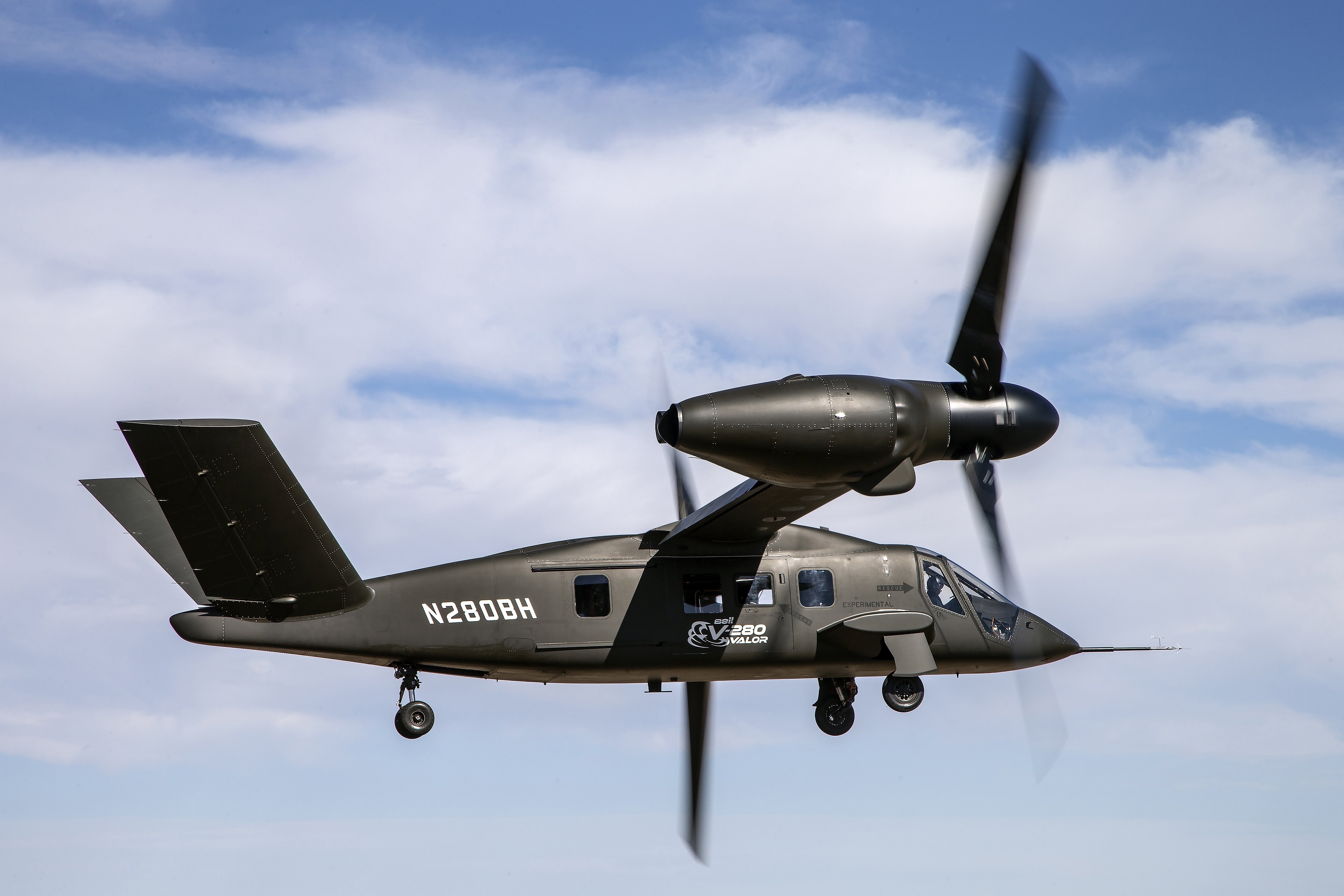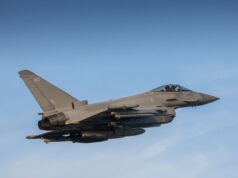The V-280 Valor has now achieved its latest milestone, its first ever flight in cruise mode.
The Bell V-280 Valor is a tiltrotor aircraft being developed by Bell Helicopter and Lockheed Martin for the United States Army’s Future Vertical Lift (FVL) programme.
The V-280 is reported to be designed for a cruising speed of 280 knots a top speed of 300 knots, a range of 2,100 nautical miles and an effective combat range of 500 to 800 nmi. Expected maximum takeoff weight is around 30,000 lb say Bell.
In one major difference from the earlier V-22 Osprey tiltrotor, the engines remain in place while the rotors and drive shafts tilt. A driveshaft runs through the straight wing, allowing both prop rotors to be driven by a single engine in the event of engine loss.
The V-280 will have a crew of 4 and be capable of transporting up to 14 troops. Dual cargo hooks will give it a lift capacity to carry a 10,000 lb M777A2 Howitzer while flying at a speed of 150 knots.
Special emphasis has been placed on reducing the weight of the V-280 in comparison to the V-22, which in turn would reduce cost. To do this, composites are used extensively in the wing, fuselage, and tail. Wing skins and ribs are made of a honeycomb-stiffened “sandwich” construction with large-cell carbon cores for fewer, larger, and lighter parts. Skins and ribs are paste-bonded together to eliminate fasteners. With these measures, costs are reduced by over 30 percent compared to a scaled V-22 wing.














I think the Andrew just found its F-35B air tankers, RAS solid support aircraft and faster delivery SOP for the Marines. Putting Crowsnest on these should be easy given Lockheed Martin’s involvement which will free up valuable Merlins
But like the Apache any bought for the Navy (and / or the Army) should be built in Yeovil …
Why put crowsnest on a platform that has a cruising speed of 280 knots, is’nt that a bit like putting a roofrack on a Mclaren Senna ? Would’nt it be cheaper just to buy more Merlins ?
(Chris H) Steven – You select one aspect (speed) for criticism forgetting speed can be controlled to be at the best for the system’s performance. My point was far wider – this aircraft has both range and height advantages over the Merlin and from what I read it has loiter advantage as well. It just seems (to me) a better bet than the Osprey given that aircraft’s cost and size.
It wasn’t solely about releasing Merlins for other duties. That is an added bonus.
I’ve seen some people question even V-22 for air-to-air refuelling based on insufficient fuel capacity to make it appreciably better than F-35B buddy refueling. I don’t have the expertise to know if there is any validity to those criticisms but, if there is, then surely the smaller size of V-280 would compromise it even more in the AAR role. I’d be interested to hear what others think.
For Crowsnest yes, anything that can be hosted on QEC and can lift the required weight of crew and equipment to an appreciably greater height than Merlin while retaining the same or better time on station is well worth looking at.
I think it’s too small for a useful RAS or tanker capability Chris.
Also forget Yeovil, unless you want to double the unit price with most of the profits heading to Italy anyway.
(Chris H) John – Ah yes the old ‘Price’ versus ‘Nett Cost’ debate when spending taxpayer’s money. I have rehearsed this many times so won’t repeat it here. And actually I believe its better for just any profits to go to Italy if they have employed British people than have the whole amount go to the USA for us to employ American people.
[…] post Bell V-280 Valor tiltrotor makes first ever cruise mode flight appeared first on UK Defence […]
Given that there is a jet VSTOL engine out there, the F135-600, has nobody though about a transport/utility aircraft using this engine or even a pair of them? Wouldn’t that then have commonality of parts with the strike platform (F-35) ?
(Chris H) Paul – I would have thought that given the huge fans and flaps needed to balance the large single hot gas output involved in the F135 as fitted to the F-35 B a pair of wing mounted RR Pegasus engines with 8 (4 hot 4 cold) variable nozzles would actually work better and be far simpler to maintain. And all the spares and training are already in place.
There you go BAE ……
That engine was specifically developed for the F-35 programme, the thrust vectoring the F-35B employs to achieve its STOVL capabilities are far less efficient aerodynamically than the tilt-rotor methods employed by both the V-22 Osprey and this example. The kinds of roles being discussed for such an aircraft in the RN – such as AEW, RAS, aerial refuelling etc. are not roles which rely on high speed performance for their success, rather this is something which would arguably hinder their effectiveness. Whilst it is true that one of the advantages of tilt-rotor aircraft over conventional rotorcraft is speed, in these roles it would seem that the advantages of range, take of weight and fuel efficiency are those which are of most value, but also those which would be most hindered by an unnecessarily gas-guzzling engine designed for a fifth generation strike aircraft. So no, ultimately I would say that a turboprop design would be more suited to the envisaged roles.
Daniel a couple of thoughts on your answer. Absolute takeoff weight would be more with twin F135-600 aircraft even in STOL mode and as such more fuel capacity for the aerial refuelling option. More weight for use as RAS. I am assuming that a utility aircraft would be designed more around lift generation and aerodynamics than around stealth. I do not know enough about engine design to say at what thrust setting the F135-600 is the most fuel efficient and whether this could be improved via the engine management software. Airspeeds for a2a refuelling would be much more in sync with the F35.
My thoughts were a high wing design with the engines on the fuselage side/wing root, giving a stable 4 air column design for VTOL performance. It should be able to use the ski jump on the QN class carriers the rolling landing being developed for the F-35.
Finally as I understand it the F-35 comes with plenty of electrical power, I assume that this could be carried forward into the utility aircraft and use to power the AEW requirement.
I am guessing that what I describe would end up being far too expensive in terms of development unless a US service would be interested (prob the USMC) and the are invested in the V-22 Osprey.
So this could place an M777 pretty much anywhere, at speed. Pretty handy.
So the cost of one of these would be?
Bell Helicopter anticipates somewhere between $28-32 million per unit. Possibly $25 million if the US Army orders enough. Compared to $72-75 million for the Osprey.
Thanks Elliott.
Certainly affordable then.
The new iteration of the Searchwater radar that is part of the crowsnest program will use a rotating AESA antenna panel (think Sampson) hidden inside the inflatable bag when fitted to Merlins. The system has been constantly developed over the years and has proven itself both over land and sea.
If this was to be fitted to a higher speed fixed wing aircraft or a tiltrotor, the bag would cause too much drag. Therefor the antenna could be fixed to the airframe but in four locations to give 360 coverage.
I confess I didn’t know that the new Searchwater was AESA. That’s great to hear.
Being pedantic, is that rotating panel or panels since Sampson is actually a back-to-back pair of rotating panels isn’t it?
As far as I know it’s a single panel AESA array, with a high rotation speed.
The Navy really needs to find a better aircraft for operating the Seaspray radar. I know fitting it to Merlin is due to the lack of available airframes and its relatively cheap. But it is operationally hamstringing the radar because its limited to operate up to 12,000ft, which gives the radar a shorter over the horizon range.
We need to jump in bed with the USMC with their Bell V247 tiltrotor drone. This would free up the Merlins to carryout their primary task of sub hunting! The V247 has the lifting capacity to carry the seaspray but more importantly the electrical power generation, notwithstanding the operating height advantage (28,000ft).